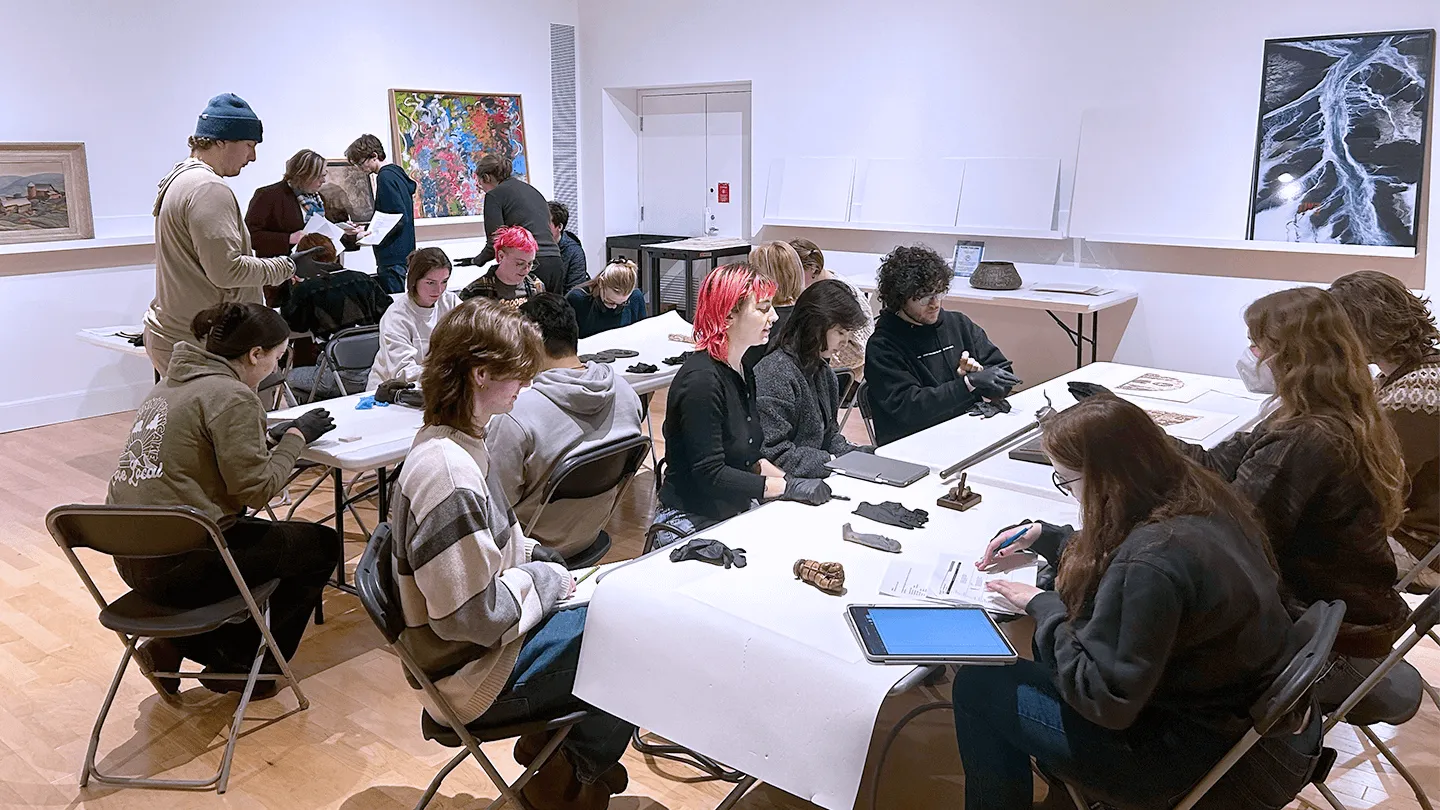With more than 24,000 works in its collection, the Fleming Museum is an amazing resource for students and faculty right here on the University of Vermont (UVM) campus. The Fleming’s Learning Studio adds to this wealth of information and opportunities by offering a space within the museum where faculty, students, and the public can view and explore art and cultural heritage objects from the museum’s collection in a unique gallery-meets-classroom environment.
“The Learning Studio allows us to temporarily display art and objects not currently on view in our galleries,” says Phil Morin, manager of Campus and Community Engagement at the Fleming. These short-term installations, which can last anywhere from a few hours to a few days, may be requested for specific UVM courses or research by students and faculty, or presented as themed pop-up exhibits that are open to the public.
A variety of programs and disciplines use the space for teaching—from English courses that look to antique dolls for creative writing inspiration, to herpetology courses that examine historical representations of amphibians and reptiles in art, to natural-resources courses that investigate examples of land use and stewardship in 18th-century landscapes.
This spring, Jennifer Dickinson, Ph.D., associate professor of anthropology and vice provost for Academic Affairs and Student Success, is conducting her Museum Anthropology class at the Learning Studio.
Dickinson’s students are working in groups to conduct research on the Fleming’s collection and put together proposals for future installations at the museum. When the class meets at the museum each week, the students get to choose what to work on from a group of objects presented by the museum staff. Over the course of the semester, each group will curate about 40 separate objects, then create their exhibit proposal using some of those objects.
This year, Dickinson’s class is focusing on memory and memorialization, so all the curated objects have some connection to this theme. They will be looking at everything from a teapot commemorating the 1824 tour of the United States by French nobleman and American Revolutionary War hero the Marquis de Lafayette to student scrapbooks from the UVM archives.
“This year, we are really striving to take full advantage of locating the class in the museum,” Dickinson says. She adds that a high proportion of students in the class are interested in pursuing museum careers. So, in addition to working with museum staff on their projects, students get the chance to hear from them about their diverse paths into museum work and receive recommendations for developing their skills.
Morin adds that the Learning Studio enables students to engage with art and objects that are rarely—sometimes never—put out on display to the public. With museum staff members available for object handling, the Learning Studio fosters a level of close observation that isn’t available elsewhere in the museum. “Without stanchions, glass, acrylic, or other barriers, students can study and explore with a familiarity that is unmatched in any gallery space or exhibition at the Fleming,” Morin says.
“Working in the Learning Studio to make collections accessible to students and faculty is one of my favorite parts of my job,” says Margaret Tamulonis, manager of Collections and Exhibitions at the Fleming. She says she has witnessed the ways students are able to really look at art and talk about it with each other, reacting to the objects in excited and interested ways. “I have pulled objects for viewing that I am very familiar with, that we have pulled out for classes a few times in the past, and students will always notice something new about them.”
One goal for the class is to improve understanding of the Fleming collections through student research, so each proposed installation will have the intention of helping visitors to the Fleming learn more about the collections. “At the same time,” Dickinson says, “in the class we are thinking a lot about memory in and beyond museums and also processes of memorialization.” She expects that each group will use their exhibit design to encourage museum visitors to think through some of the same questions they have been discussing throughout the semester.
“It is just incredibly fun to watch students catch the museum bug and develop a whole set of skills in research, design, and writing throughout the semester,” Dickinson says. “I can already tell that this year’s class is one of the best we’ve had, and each week it’s a pleasure to go to class and engage with them about these ideas.” She adds that working together in a group to design an exhibit also presents challenges, so it’s especially gratifying to see final presentations that showcase the creativity and insights of each student.
And that’s precisely why the Learning Studio exists. “It feels different than a classroom,” Tamulonis says. “It is a place of solace and learning, where we get to share objects that can’t always be on view and make a space for deep looking and thoughtful conversation—or even just an ‘Oh, wow!’”
To reserve the Learning Studio, interested faculty can submit a group visit request form found on the Fleming’s website.
